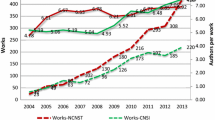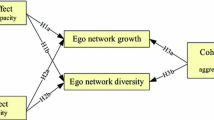Abstract
The purpose of this paper is to comprehensively explore scientific research profiles in the field of emerging nano-energy during 1991–2012 based on bibliometrics and social network analysis. We investigate the growth pattern of research output, and then carry out across countries/regions comparisons on research performances. Furthermore, we examine scientific collaboration across countries/regions by analyzing collaborative intensity and networks in 3- to 4-year intervals. Results indicate with an impressively exponential growth pattern of nano-energy articles, the world share of scientific “giants,” such as the USA, Germany, England, France and Japan, display decreasing research trends, especially in the USA. Emerging economies, including China, South Korea and India, exhibit a rise in terms of the world share, illustrating strong development momentum of these countries in nano-energy research. Strikingly, China displays a remarkable rise in scientific influence rivaling Germany, Japan, France, and England in the last few years. Finally, the scientific collaborative network in nano-energy research has expanded steadily. Although the USA and several major European countries play significantly roles on scientific collaboration, China and South Korea exert great influence on scientific collaboration in recent years. The findings imply that emerging economies can earn competitive advantages in some emerging fields by properly engaging a catch-up strategy.




Similar content being viewed by others
Notes
Web of science provides address information for England, Scotland, Wales, Northern Ireland, China, and Hong Kong separately. In this paper, England, Scotland, Northern Ireland, and Wales were viewed as independent units as Mallik and Mandal (2014) did. We also regarded China and Hong Kong as independent units in this scientific field, so nano-energy articles for China in this study did not include nano-energy articles for Hong Kong.
References
Alivisatos P, Cummings P, De Yoreo J, Fishthorn K, Gates B, Hwang R, Lowndes D, Majumdar A, Makowski L, Michalske T (2005) Nanoscience research for energy needs. http://eprints.internano.org/73/1/DoE_Nanocience_Research_for_Energy.pdf
Arora SK, Porter AL, Youtie J, Shapira P (2013) Capturing new developments in an emerging technology: an updated search strategy for identifying nanotechnology research outputs. Scientometrics 95(1):351–370
Bajwa RS, Yaldram K, Rafique S (2013) A scientometric assessment of research output in nanoscience and nanotechnology: Pakistan perspective. Scientometrics 94(1):333–342
Bhushan B (2010) Introduction to nanotechnology. In: Bhushan B (ed) Springer handbook of nanotechnology. Springer, Berlin, pp 1–13
Bornmann L, Anegon FD, Leydesdorff L (2012) The new excellence indicator in the world report of the SCImago Institutions Rankings 2011. J Informetr 6(2):333–335
Chen XB, Li C, Gratzel M, Kostecki R, Mao SS (2012) Nanomaterials for renewable energy production and storage. Chem Soc Rev 41(23):7909–7937
de Solla Price DJ (1963) Little science, big science. Columbia University Press, New York
Diallo MS, Fromer NA, Jhon MS (2013) Nanotechnology for sustainable development: retrospective and outlook. J Nanopart Res 15(11):2044
Dong BS, Xu GQ, Luo X, Cai Y, Gao W (2012) A bibliometric analysis of solar power research from 1991 to 2010. Scientometrics 93(3):1101–1117
EIA U (2013) International energy outlook 2013. United States Energy Information Administration, Washington. http://www.eia.gov/forecasts/ieo/world.cfm
Fisher RA (1921) Some remarks on the methods formulated in a recent article on “The quantitative analysis of plant growth”. Ann Appl Biol 7(4):367–372
Fromer NA, Diallo MS (2013) Nanotechnology and clean energy: sustainable utilization and supply of critical materials. J Nanopart Res 15(11):2011
Gonzalez-Brambila CN, Veloso FM, Krackhardt D (2013) The impact of network embeddedness on research output. Res Policy 42(9):1555–1567
Guan J, Gao X (2008) Comparison and evaluation of Chinese research performance in the field of bioinformatics. Scientometrics 75(2):357–379
Guo KW (2012) Green nanotechnology of trends in future energy: a review. Int J Energy Res 36(1):1–17
Hirsch JE (2005) An index to quantify an individual’s scientific research output. Proc Natl Acad Sci USA 102(46):16569–16572
Huang C, Notten A, Rasters N (2011) Nanoscience and technology publications and patents: a review of social science studies and search strategies. J Technol Transf 36(2):145–172
Li EY, Liao CH, Yen HR (2013) Co-authorship networks and research impact: a social capital perspective. Res Policy 42(9):1515–1530
Liu W, Gu M, Hu G, Li C, Liao H, Tang L, Shapira P (2013) Profile of developments in biomass-based bioenergy research: a 20-year perspective. Scientometrics. doi: 10.1007/s11192-013-1152-z
Mahapatra M (1985) On the validity of the theory of exponential growth of scientific literature. In: 15th IASLIC conference proceedings, IASLIC, Bangalore, pp 61–70
Mallik A, Mandal N (2014) Bibliometric analysis of global publication output and collaboration structure study in microRNA research. Scientometrics 98:2011–2037
Menendez-Manjon A, Moldenhauer K, Wagener P, Barcikowski S (2011) Nano-energy research trends: bibliometrical analysis of nanotechnology research in the energy sector. J Nanopart Res 13(9):3911–3922
Milojevic S (2012) Multidisciplinary cognitive content of nanoscience and nanotechnology. J Nanopart Res 14(1):685
Molinari JF, Molinari A (2008) A new methodology for ranking scientific institutions. Scientometrics 75(1):163–174
Plc BP (2013) BP energy outlook 2030. London, UK. http://www.bp.com/en/global/corporate/about-bp/statistical-review-of-world-energy-2013/energy-outlook-2030.html
Porter AL, Youtie J, Shapira P, Schoeneck DJ (2008) Refining search terms for nanotechnology. J Nanopart Res 10(5):715–728
Roco MC, Mirkin CA, Hersam MC (2011) Nanotechnology research directions for societal needs in 2020: summary of international study. J Nanopart Res 13(3):897–919
Sanz-Casado E, Garcia-Zorita JC, Serrano-Lopez AE, Larsen B, Ingwersen P (2013) Renewable energy research 1995–2009: a case study of wind power research in EU, Spain, Germany and Denmark. Scientometrics 95(1):197–224
Sci2Team (2009) Science of science (Sci2) tool. Indiana University and SciTech Strategies. http://sci2.cns.iu.edu
Serrano E, Rus G, Garcia-Martinez J (2009) Nanotechnology for sustainable energy. Renew Sust Energ Rev 13(9):2373–2384
So DS, Kim CW, Chung PS, Jhon MS (2012) Nanotechnology policy in Korea for sustainable growth. J Nanopart Res 14(6):854
Tang L, Shapira P (2011) China–US scientific collaboration in nanotechnology: patterns and dynamics. Scientometrics 88(1):1–16
Tegart G (2009) Energy and nanotechnologies: priority areas for Australia’s future. Technol Forecast Soc Change 76(9):1240–1246
Acknowledgments
This study is supported by a Grant from National Natural Science Foundation of China (No. 71373254). The authors are very grateful for the valuable comments and suggestions from the anonymous reviewers. The authors also wish to thank the Editor of the Journal for his careful English corrections of the article, which significantly improved the readability of the paper.
Author information
Authors and Affiliations
Corresponding author
Additional information
The paper is a perspective paper to describe the general tendency and to make a cross-countries/regions comparison of scientific research in emerging nano-energy field.
The authors’ names are alphabetically ordered and they contributed equally to this paper.
Rights and permissions
About this article
Cite this article
Guan, J., Liu, N. Measuring scientific research in emerging nano-energy field. J Nanopart Res 16, 2356 (2014). https://doi.org/10.1007/s11051-014-2356-8
Received:
Accepted:
Published:
DOI: https://doi.org/10.1007/s11051-014-2356-8




